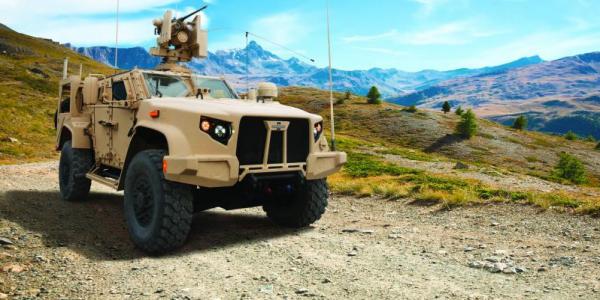Marines Size Up Laser Weapons
For the Marines to be able to employ these laser weapons, the technologies must be as efficient and as small as possible.
U.S. Marine Corps operations are demanding. Weapons need to be ruggedized and mobile for quick assaults. And high-energy laser weapons such as those the Navy is developing will be large and draw high levels of power. For the Marines to be able to employ these laser weapons, the technologies must be as efficient and as small as possible, says Jeff Tomczak, deputy director of the Science & Technology (S&T) Division at the Marine Corps Warfighting Laboratory.
For lasers—and really all weapon systems—in Marine Corps applications, the focus primarily is to make capabilities as light and as expeditionary as possible. Tomczak emphasizes that weapon size matters when warfighters have to get gear ashore.
“We know and have found that the larger and heavier things get into the fight a little slower than lighter things that we can carry quickly,” he explains. “If you have the right things in the right place at the right time, you may not need the bigger things.”
Keeping size, weight and power considerations in mind, the Warfighting Laboratory is working closely with the Office of Naval Research (ONR) to develop directed energy technologies, including lasers the Marines can use to counter air, ground, surface and subsurface unmanned system threats. The Marines collectively call these myriad devices “U-Excess.” Tomczak says he sees the proliferation of these devices, especially unmanned aerial vehicles (UAVs), as a huge threat. “There is great potential that the enemy will be using UAVs in the same way we have used cruise missiles and tomahawk missiles,” he warns.
Lasers can prevent adversaries from using systems in an affordable manner, turning the table on the cost equation, Tomczak attests. “It’s not cheap to build the lasers, but it will be cheap to use them,” he says. “That is the important part for us. You are not shooting high-end missiles, expensive missiles, at very cheap unmanned systems that can be mass-produced.”
For the power range of the lasers, the lab is looking at “low power, high power and everything in between,” says the deputy director. “My job is to put arrows in the quiver and build that toolkit so that the operator has options when a threat presents itself.”
The Warfighting Laboratory seeks to provide weapon choices for quick responses to threats. “Like a golf game, a soldier has multiple clubs because the ball may be close or far, or be stuck in a sand pit,” he says. “And we have to figure out a way to provide options to soldiers, given the changing environment. You don’t know what you are going to face. It’s not just one type of threat. You need a range of options that you can choose from, to include both nonlethal and lethal weapons.”
Potentially, laser weapons could be on all future warfighting vehicles for the Marines, Tomczak offers. “That’s a physics problem right now,” he admits. “Laser weapons could fit on smaller or larger vehicles or fit on the back of an aircraft, say, on the back of the V-22 Osprey, and be there out front as Marine Corps units land in the zones.
“In the end, when we make things smaller and lighter and more affordable, with low power demands, that will serve us better based on the areas the Marines are going into,” he concludes.
The Naval Surface Warfare Center Dahlgren Division supports the Marines Corps effort to add laser weapons to its short-range capabilities. Dahlgren is the lead integrator for the Ground-Based Air Defense Directed Energy On-the-Move program, which harnesses science and technology development efforts from the ONR and the High Energy Laser Joint Technology Office (HEL-JTO), along with industry partners. Given the more demanding size, weight and power considerations for a vehicle—compared with a Navy destroyer, for example—Dahlgren had to conduct a detailed trade-off analysis as well as “significant” laser and vehicle modeling and simulation, according to the ONR.
As one of several contractors working on the program, Raytheon is supplying a 30-kilowatt (kW) gas laser using proprietary planar waveguide technology. The other components of the laser system include a lightweight reflective beam director, power enhancement, lithium-ion batteries for power storage, and a cooling system, which all have to fit within the size, weight and power constraints of a tactical ground vehicle.
Meanwhile, Boeing officials would like to see the Marines use its Compact Laser Weapons System (CLWS) on tactical vehicles—including on the forthcoming Joint Light Tactical Vehicle (JLTV). The CLWS comes in 2-, 5- and 10-kW options and can be carried by a couple of Marines. “One of the related aspects of the CLWS is that it’s a counterintelligence, surveillance and reconnaissance tool,” says Jim Leary, director, Boeing weapons global sales and marketing. “You can shoot down enemy drones that might be observing friendly troops. That’s the beauty of this laser.”
Under a $114.7 million contract with the U.S. Army Tank-automotive and Armaments Command Life Cycle Management Command in Detroit, Oshkosh Defense is outfitting the Army and Marine Corps with its JLTV to replace the Humvee. The JLTV is designed as a shell and supports multiple lethality requirements for various weapons, explains Dave Diersen, vice president and general manager of joint programs for Oshkosh Defense. The JLTV is flexible enough to integrate any type of weapon system as long as it can carry the weight. It is especially important to be a good platform for multiple types of systems, given that a vehicle may be in the field for 20, 30 or even 40 years, Diersen emphasizes. “So we will integrate those weapons onto the JLTV for whoever needs it,” he says. “We don’t have a dog in that fight.”
Diersen also says he thinks the JLTV “is a good fit for the CLWS.” The four-door vehicle is designed to take 3,500 pounds of payload, plenty to hold the system. Most of the weight of the CLWS is from the power storage system, not the laser itself. The vehicle’s diesel engine produces 10 kW of power for export to vehicle-mounted weapon systems, allowing power-hungry systems such as the CLWS to have enough juice to run. “We’ve done the analysis, and there is no problem with carrying the laser weapon system on the JLTV,” Diersen confirms.
The JLTV is currently in low-rate initial production, and the company anticipates a full-rate production decision in the next fiscal year, he says. The first Army unit will be equipped with a JLTV by the middle of the next fiscal year, with both Army and Marine Corps initial operating capability achieved in early FY 2020. Oshkosh Defense will provide the vehicles through August 2024.





Comments